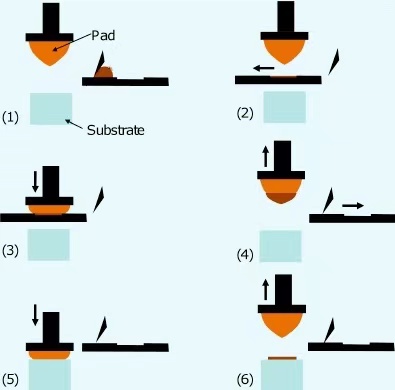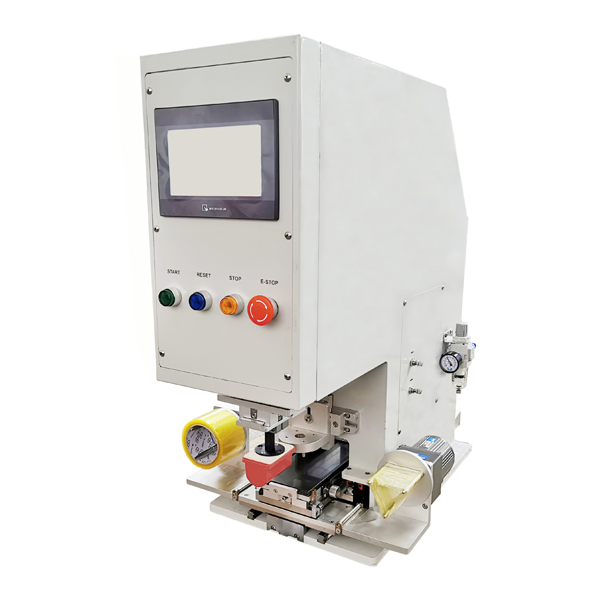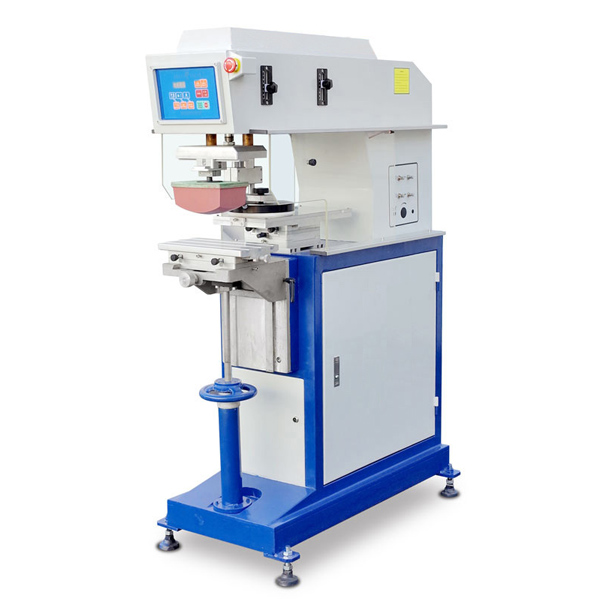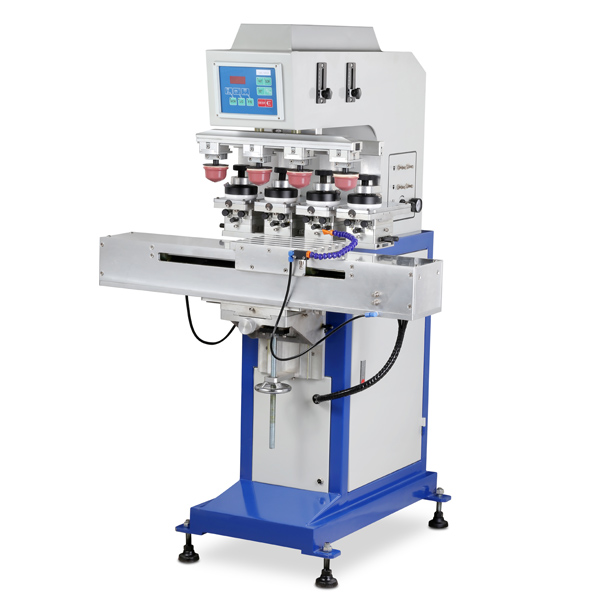
LED BULB PAD PRINTING MACHINE
is versatile for pad printing on all kinds of materials including LED bulb.The
siliconpad of led bulb printing machine transfers a 2-D image on laser etched
printing plate to the 3-D object, LED bulb.
4 primary pad printing supplies:
image plate, printing ink, silicone printing pad and rubber.
HOW TO PAD PRINT A LED BULB?
Step 1:Put the closed ink cup on the etched artwork area on pad print plate to cover the LED bulb logo and fill it with ink. It is called home position.
Step 2: Move the closed ink cup away from the etched artwork area and take all excessive pad printer ink and expose the etched LED bulb logo filled with ink. As soon as the top layer of pad printer ink is exposed to air, it becomes tacky. By this way, the pad printer ink adheres to the pad and then to the LED bulb.
Step 3:Press the pad down onto the plate immediately. The compressed pad pushed the air outward and lift the ink from the etched artwork area on the pad.
Step 4:Pick up the tacky film in the etched artwork area on the pad when the pad lifts away. A little ink stays in the pad print plate.
Step 5:The ink cup moves covering the etched artwork area of the plate when the pad moves forward. Preparing for the next cycle, the ink cup refill in the etched LED bulb logo of the transfer plate.
Step 6: The pad compresses the product to transfer the ink layer from the print pad plate to the surface of LED bulb. Later, the pad lifts the substrate and goes back to the normal position.

4 TYPES OF BULB PRINTING MACHINES

SM-215-90 is a tabletop led bulb pad printing machine with an up/down drive and front/rear drive, all driven by servo motors. All operations can be adjusted and programmed on the touch screen and controlled by the brand PLC. The led bulb pad printing machine has stable working performance and can achieve high-precision led bulb printing. The ink cup size of this pad printer is 90x100mm and the printing plate size is 100x215mm. It is widely used in small parts printing, especially high-standard parts, such as auto parts, electronic parts, etc. This tabletop led bulb logo printing machine is also suitable for production integration lines

OIE one-color led bulb logo printing machine is one of the common types of led bulb pad printing machines, which can only print one color. Most of our one-color pad printing machines for led bulb are equipped with closed ink cups. This one-color pad printing machine has a variety of sizes to choose from, and can print various types of products, such as various bottles, packaging boxes, barcodes and other simple patterns. This one-color bulb printing machine is equipped with a sturdy welded steel base and has an adjustable floor leveler and a height-adjustable worktable. The standard machines are all pneumatically driven and controlled by PCB. We also have different models, such as servo-driven, belt cleaning, etc. We also provide complete pad printing kits.

OIE two-color pad printing machine for led bulb is divided into 3 series: 125 series – suitable for printing small size parts; 160 series – suitable for printing medium size parts; 200 series – suitable for printing large size parts. There are two common types of OIE two-color pad printing machines, one is equipped with a shuttle worktable, another with a pad transport shuttle. This standard two-color pad printing machine is pneumatic driven, but we have other different types of machines such as servo motor driven pad printers. And we also provide full pad printing kits.

The standard models of OIE four-color led bulb name printing machines are OIE-160C-4 and OIE-200C-4. This four-color led bulb pad printing machine is a shuttle worktable type. The standard ink cup size is 90x100mm; the required ink cup size can also be customized according to different printing products. The four-color pad pringting machine for led bulb is controlled by pneumatic drive and PCB board, and it can also be driven by a PLC control servo according to different printing requirements. Four-color pad printing machine for led bulb is widely used in the printing of toys, stationery, electronic parts and other products.
01.Versatile
Led bulb printing provides incredible image resolution and clarity, able to vary edges, tones and details of a printed image. Pad Printing machine for led bulb is applied for objects with flatter surface and simpler geometry.
02. Customized Pad and Plate
Led bulb printing is able to customize image plate and the rubber pad according to customers’ design requirements. Although pad printing is more expensive, it produces extremely
reliable and accurate image results. More modernized bulb printing machine includes precise robotic printing and accuracy measurement guided by laser, able to accommodate products of a wider range. Pad Printing machine for led bulb also can cooperate with products of different heights to print images on higher and lower areas at the same time.
03.Ink Composition
Ink composition is an advantage for led bulb printing machine. Selecting the proper ink is ultimately decided by the printed surfaces. There are two categories of surfaces: ink of one component and two components. One component ink is suitable for thermoplastic surfaces like Polyethylene, Polystyrene, PVC, and Polypropylene. Two component ink with features of hardening chemical and ink is commonly used for objects subject to high mechanical stress or chemical exposure.
01.Motive Size
The size of motive is limited by pad, plate, and efficiency of led bulb name printing machine. The diameter of the biggest efficiently printed motive is 30 cm currently.
02. Layer Thickness For Ink Film
The pad process uses plate with depth up to 20-25µm. Therefore traditional inks result in ink film of approx. 7µm. The layer thickness can be increased with multi-layer printing, but rough particle is difficult to print efficiently.
03. Printing Speed
The printing speed is relatively slower for limited pretreatment of pad printing machine for led bulb.
1.Ink Cannot Stick to the Part
The material’s surface energy is too low. The dyne level for ink to stick to a pert is 42 or better. It’s also helpful to add an adhesive modifier to the ink when the material surface is of minimum energy.
Another culprit is contamination. The residuary oil from mold-release, upstream or perspiration of handlers may become the barrier to efficient ink adhesion or transfer. Human handlers should keep away from agents of mold-release and the image area on parts.
Use the ink wrongly or test too early. Before initiating production, handlers must test adhesion additives, inks and chemical resistance. There is no ink can adhere to everything or satisfy all performance requirements. led bulb pad printing machine need to seek help from their suppliers to evaluate with print test.
It’s a common issue to test too soon. Every ink is post-curing, that is, dry as it is, it hasn’t cured to the degree with maximum chemical and adhesion resistance. UV-cured ink can also post-cure for a day after being used, while two-component ink for 2-5 days. Before testing quality control, abide by curing and drying recommendation of ink manufacturers.
2. The Led Bulb Pad Printing Machine Cannot Doctor the Cliches
The doctor ring of ink cup is damaged. Doctor rings are mostly porcelainous. If handled properly, they can keep several thousand cycles. It is time to change the doctor ring when tits sharp end wears to a 0.25mm flat edge and starts smearing the ink.
Poor maintenance of ink cup. A flexible O-ring is designed in most cups to provide an interference fit between the doctor ring and the cup. It allows the doctor ring to contact intimately with the cliché surface when it changes direction and traverses the cliché within the cycle. The doctor ring fails to flex or float and leaks out if the ink up not properly maintained or cleaned.
Skimp on ink. Ink is like the lubricant for ink cup in doctoring. A minimum amount of ink is designed in most ink cups to allow the cup to efficiently doctor the cliché. When run production is short, people usually skimp on ink, especially when using the two-component ink. That’s for two-component ink has to be abandoned after the pot life expires. The ink level of the ink cup must to be enough to wet the cliché over the inside diameter of the cup of every cycle.If not wetted sufficiently, the cup is unable to clean sufficiently the surface of the cliché.
Scooping. Scooping sometimes occurs in magnetic ink cups on laser etched clichés and thin photopolymer. The magnetic pull of the clichés may deflect the cliché for the design of ink cup, the doctor ring scooping ink out of the image area. The highest deflection degree is caused by magnet in the image area. Sometimes, this can be eliminated with a spacer on the cup to increase the distance between the cliché surface and the magnet.
3.Poor Print Quality
Manipulate solvent evaporation properly to make led bulb pad printing machine work well, otherwise, it won’t effectively transfer and pick up with wet ink. According to the capability of machines, workers should program short delay in the cycle allowing more time for ink to change physically for complete transfer.
When program delay is impossible, blow low-pressure air of low-volume to the pad between the transfer and image pick-up to quicken the solvent evaporation. It’s also helpful to do so if printing colors within the cycle. When neither air nor delay is possible, use a thinner with a faster evaporation rate. If the cycle is faster, faster thinner, air, and specific etch depth of cliche may be required.
